Sociology > EXAM > SOCIOLOGY 200 > Chapter 1 Test Bank (2019), Louisiana State University, Graded straight A (All)
SOCIOLOGY 200 > Chapter 1 Test Bank (2019), Louisiana State University, Graded straight A
Document Content and Description Below
1. As defined by C. Wright Mills, which of the following “enables us to grasp history and biography and the relations between the two within society”? a. formal sociology b. sociological imagi... nation c. microsociology d. macrosociology 2. Feeling discomfort about rural Chinese society, where many generations of a family sleep in the same bed, is known as: a. xenophobia. b. Verstehen. c. social identity. d. social ecology. 3. How does the textbook author use dialogue from Pulp Fiction, in which the characters discuss how in Holland people put mayonnaise on their french fries? a. to introduce the sociology of film b. to explain the sociological imagination c. to explain social institutions d. to define formal sociology 4. A female manager is attempting to climb her way to the top of the corporate ladder. She works as hard, if not harder, than her male colleagues, but nothing she seems to do helps her advance. She begins to notice that males are being promoted, but females tend to be overlooked for advancements. The realization that many women in her circumstance are experiencing the same discrimination is an example of: a. anomie. b. Verstehen. c. sociological imagination. d. social cohesion. 5. Sociologists and economists have shown that the benefits of higher education include higher median incomes for college graduates. This is known as: a. educational investment. b. the returns to schooling. c. study hard or be poor. d. get an education; get a job. 6. After doing some sociological math, what is the net difference between the annual earnings of the average high school versus college graduate? a. about $5,000 per year b. about $10,000 per year c. about $15,000 per year d. about $50,000 per year 7. According to Randall Collins’s (1979) research, the expansion of higher education is: a. mainly caused by the globalization of capitalism. b. likely caused by less-prepared high school students entering college. c. a result of credentialism and expenditures on formal education. d. a result of increasing governmental interference in educational funding. 8. According to research used to question credentialism, what might it cost to buy a college diploma online? a. $29.95 b. $99.99 c. $250.00 d. at least $1,000 9. In today’s society, Randall Collins might suggest that getting a “piece of paper” is more important to many than actually having the knowledge to do a job. He calls the priority placed on formal education: a. secondary education. b. credentialism. c. normlessness. d. xenophobia. 10. All of the following are examples of social institutions used to prevent websites from undermining colleges’ degree-conferring abilities EXCEPT: a. copyright law. b. police forces. c. employers. d. families. 11. Which of the following is defined as a set of stories embedded within a social network about the standard ways a society meets its needs? a. a social identity b. a social institution c. a theory d. anomie 12. The author of your text states that the most age-segregated social institution in our society is: a. a hospital. b. a mental institution. c. a prison. d. a four-year college. 13. A family, as a group of people living together sharing individual stories, makes up a(n): a. social institution. b. conflict institution. c. anomic institution. d. creative institution. 14. The Phillip Morris Company changed its name to Altira in an attempt to start a new: a. line of cigarettes. b. defense against law suits. c. social identity. d. multinational company. 15. The “grand narrative” that constitutes a social identity: a. is nothing more than a sum of individual stories told between pairs of individuals. b. remains the same throughout time. c. can only be defined by the individual him- or herself. d. is best displayed online on MySpace and Facebook. 16. As a formal field, sociology is a relatively ____________ discipline, as discussed in Chapter 1. a. old b. established c. young d. conservative 17. Who was the author of the first methods book in the discipline of sociology? a. Emile Durkheim b. Harriet Martineau c. Jane Addams d. Max Weber 18. In the book How to Observe Morals and Manners, the institution of marriage is criticized as: a. based on an assumption of the inferiority of women. b. based on an assumption of the inferiority of men. c. reinforcing compulsory heterosexuality. d. perpetuating social class stratification. ANS: A DIF: Moderate REF: Page 18 TOP: Factual OBJ: August Comte and Harriet Martineau | Feminist Theory 19. Which of the following sociologists developed the theory of positivism? a. Auguste Comte b. Emile Durkheim c. Karl Marx d. Max Weber 20. Positivism is best defined as: a. the idea that we can scientifically and logically study social institutions and the individuals within them. b. the effect of religion on social institutions and the individuals within them. c. the study of the symbolic interactions between social institutions and the individuals within them. d. the relationship between scientific and religious social institutions. ANS: A DIF: Difficult REF: Page 16 TOP: Factual OBJ: Positivism 21. According to Comte, positivism arose out of a need to make ____________ sense of the social order in a time of declining religious authority. a. scientific b. moral c. rational d. economic 22. The person that is often considered to be the founding father of positivism is: a. Émile Durkheim. b. Karl Marx. c. Georg Simmel. d. George Herbert Mead. 23. All of the following are known as the three epistemological stages of human society, as explained by Comte, EXCEPT: a. the theological stage. b. the metaphysical stage. c. the scientific stage. d. the post-scientific stage. 24. Which of the three historical epistemological stages of human society did Comte explain was highlighted by Enlightenment thinking such as Rousseau’s, Mill’s, and Hobbes’s beliefs in biological causes for human behavior? a. the theological stage b. the metaphysical stage c. the scientific stage d. the post-scientific stage 25. Which of the three historical epistemological stages of human society did Comte claim was characterized by the development of social physics to explain human behavior? a. the theological stage b. the metaphysical stage c. the scientific stage d. the post-scientific stage 26. Which of the three historical epistemological stages did Comte argue would explain human society by consulting the Bible or other religious texts? a. the theological stage b. the metaphysical stage c. the scientific stage d. the post-scientific stage 27. Which of the following are known as “the founding fathers of the sociological discipline”? a. Comte, Martineau, and Marx b. Martineau, Addams, and Weber c. Durkheim, Marx, and Weber d. Cooley, Park, and Mead 28. Which of the following founders of sociology is known, in part, for having his writings become the basis of Communism? a. Auguste Comte b. Émile Durkheim c. Karl Marx d. Max Weber 29. To Marx, conflict between a small number of capitalists and a large number of workers would divide society. He referred to this large number of workers as: a. employees. b. proletariat. c. subordinates. d. slaves. 30. Karl Marx would argue that the types of social institutions in a society were the result of the economic makeup of that society. Max Weber, however, argued that: a. there are no social institutions in a society. b. there are multiple influences (e.g., religion) on how social institutions are created. c. social institutions are not influenced by the economy, but by the individuals in them. d. the epistemological stage of that society influenced the social institutions. 31. Who criticized Marx for focusing exclusively on economics and social class as explanations for human behavior, and advocated sociological analyses that allowed for multiple influences? a. Auguste Comte b. Harriet Martineau c. Georg Simmel d. Max Weber 32. Who wrote The Protestant Ethic and the Spirit of Capitalism? a. Karl Marx b. Georg Simmel c. Harriet Martineau d. Max Weber 33. The author of The Protestant Ethic and the Spirit of Capitalism argued that sociologists should study social behavior from the perspective of the people engaging in it. This is known as: a. functionalism. b. historical materialism. c. xenophobia. d. Verstehen. 34. Max Weber would say we need to understand, from their perspective, not from our own, why many generations of Chinese sleep together in rural China. He called this: a. anomie. b. normlessness. c. Verstehen. d. positivism. 35. Which of the following is the study of social meanings that emphasizes subjectivity in understanding human behavior? a. interpretive sociology b. formal sociology c. social ecology d. positivism 36. The Division of Labor in Society was the first of many sociological contributions from: a. Auguste Comte. b. Émile Durkheim. c. Karl Marx. d. Max Weber. 37. According to the theory of social solidarity, the division of labor in a society helps to determine: a. the sociological contribution of individuals. b. the way urbanism affects the cohesion of individuals. c. the way social cohesion among individuals is maintained. d. the way social norms are created and maintained. 38. Which of the following sociologists wrote Suicide in 1897? a. Auguste Comte b. Émile Durkheim c. Karl Marx d. Max Weber 39. According to Suicide, one of the main social forces leading to suicide is a sense of normlessness that results from drastic changes in society. This normlessness was called: a. anomie. b. the division of labor. c. social solidarity. d. functionalism. 40. American sociology in the United States began at which of the following universities? a. American University b. University of Chicago c. New York University (NYU) d. Columbia University 41. The basic premise of the Chicago School was that human behaviors and personalities are shaped by social and physical environments. This is known as: a. formal sociology. b. interpretive sociology. c. social ecology. d. Verstehen. 42. Which early U.S. sociologist told other sociologists in the Chicago School to “go out and get the seats of [their] pants dirty in real research”? a. Charles H. Cooley b. George H. Mead c. Robert Park d. Louis Wirth 43. The Chicago School’s main laboratory for sociological research was: a. the city of Chicago itself. b. the second floor of the University of Chicago’s dormitories. c. the state of Illinois. d. the states of Illinois and Ohio. 44. According to your textbook’s author, Chicago School researcher Louis Wirth’s essay, “Urbanism as a Way of Life,” might be classified as which of the following today? a. cultural sociology b. formal sociology c. interpretive sociology d. historical materialism 45. “If men define situations as real they are real in their consequences” is the theory of which of the following Chicago School theorists? a. Robert Park b. Charles H. Cooley c. George H. Mead d. W. I. Thomas 46. The Chicago School was a good place to study community-based social ecology. Why? a. The residents were closely related and could communicate with each other easily. b. The population was rapidly growing due to foreign immigration and the influx of African Americans from the rural South. c. Industrialization was waning in Chicago during this time, and this caused high rates of poverty and crime. d. The divorce rate in Chicago at the time was double that of other large cities. 47. Charles H. Cooley argued that the “self” emerges from how an individual interacts with others and then interprets those interactions. He calls this: a. the looking-glass self. b. the social self. c. the generalized other. d. the significant other. 48. George H. Mead described how the “self” internalizes the views of society as a whole, transcending the individual and particular situations. He calls this larger society: a. the significant other. b. the generalized other. c. the looking-glass self. d. the social self. 49. The Chicago School’s Jane Addams founded the first American settlement house, an institution to help the poor by offering aid, educational services, and more. This house is known as: a. the Chicago School. b. the Addams House. c. the Hull House. d. the University of Chicago. 50. Which of the following was the first African American to receive a Ph.D. from Harvard University? a. W. E. B. Du Bois b. Jane Addams c. Oprah Winfrey d. Barack Obama 51. Which of the following applied Durkheim’s theory of anomie to explain crime rates among African Americans after the abolition of slavery in the United States? a. W. E. B. Du Bois b. Jane Addams c. Robert Park d. Charles H. Cooley 52. A white person goes into an upscale shop to look at clothes. (S)he is excited to see that there is a sale and gathers a huge pile of clothes to take into the dressing room. An African American goes into the store and is excited about the sale, but hesitates to take many clothes into the dressing room, afraid that staff will think he or she might shoplift. W. E. B. Du Bois would say that the African American has: a. prejudice. b. low self-esteem. c. double consciousness. d. a negative self-image. 53. Which of the following modern sociological theories states that the best way to analyze society is to identify the purpose that different aspects or phenomena play in the overall structure of society? a. postmodernism b. feminism c. conflict theory d. functionalism 54. The intended purpose of desegregation of schools in the 1950s was to make education equal for everyone. What was not intended was that many racial minority teachers and principals lost their jobs. This unintended purpose was called a(n) ____________ function by functionalist theorist Talcott Parsons. a. unintended b. manifest c. mistaken d. latent 55. In contrast to functionalism, which modern sociological theory borrows from Marx’s belief that competition, not consensus, is the essential cause of social change? a. conflict theory b. feminism c. postmodernism d. midrange theory 56. The functionalist paradigm went largely unchallenged in the United States until around the 1950s. C. Wright Mills criticized Talcott Parsons for: a. spending too much time on the negative aspects of society. b. supporting the dominant class structure and the inequalities associated with it. c. addressing only the inequalities of classes. d. focusing on small-scale personal interactions and not the “whole picture.” 57. The two words that might describe the difference between conflict theory and functionalism are: a. competition versus consensus. b. microsociology versus macrosociology. c. meaning versus understanding. d. feminist versus Marxist. 58. Which feminist sociologist wrote Sex, Gender, and Society (1972), in which she or he argued that much of what we attribute to biological sex differences can actually be traced to learned behaviors and socialization? a. Jane Addams b. Harriet Martineau c. Ann Oakley d. W. E. B. Du Bois 59. Which modern sociological theory examines how power relationships are defined, shaped, and reproduced on the basis of gender differences? a. feminism b. functionalism c. human sexuality d. midrange theory 60. Which modern sociological theory explains social behavior by examining the meanings that social signals and signs represent to individuals? a. feminism b. functionalism c. symbolic interactionism d. postmodernism 61. What do symbolic interactionists study? a. midrange theory b. postmodernism c. functionalism d. shared meaning 62. Erving Goffman used the language of theater to describe how people present themselves in everyday social life. This is known as: a. sui generis b. dramaturgical theory c. functionalism d. stage theory 63. Which of the following modern sociological theories argues that there are no shared, objective meanings? a. feminism b. conflict theory c. postmodernism d. functionalism 64. Postmodern sociologists argue that all so-called objective phenomena are open to debate because all meaning is subjective. Thus, to postmodernists, all “facts” are really: a. social constructs. b. myths. c. lies. d. propaganda. 65. Some postmodern sociologists work to show us how all social phenomena are created arbitrarily by people with varying degrees of power. This is known as: a. social ecology. b. anomie. c. Verstehen. d. deconstructing. 66. Native Americans may see the history of the United States differently than white Europeans. Which theory is concerned with the fact that history may be interpreted differently by these dissimilar groups? a. midrange theory b. postmodernism c. symbolic interactionism d. functionalism 67. Robert Merton’s modern sociological theory focused on attempting to predict how certain social institutions function between microsociology and macrosociology. This is known as: a. midrange theory. b. a compromise. c. centralism. d. postmodernism. 68. In the discipline of history, focusing on historical figures such as Adolf Hitler is known as: a. “great man” theories. b. people’s histories. c. historiography. d. historical materialism. 69. Explaining unique cases is the focus of most historians, whereas the comparative method is the staple of the sociologist. This comparative method is also known as: a. people’s histories. b. the nomothetic approach. c. counterfactual. d. historiography. 70. Which area within the discipline of anthropology is most similar to sociology? a. physical anthropology b. cultural anthropology c. genetic anthropology d. forensic anthropology 71. In sociology’s “cousin,” psychology, the focus is on the individual. In sociology, the focus is above or beyond the individual, on group-level dynamics and social structures. This is known as: a. intra-individual b. inter-individual c. supra-individual d. super-individual 72. The examination of human behavior within a rational actor model is the focus of which of the following “cousins” of sociology? a. anthropology b. economics c. psychology d. the biological sciences 73. Sociology is the study of: a. how urges, drives and the mind can account for human behavior. b. group-level dynamics and social structures. c. the underlying variation or causal mechanisms within the biological nature of individuals. d. humans as rational utility maximizers. 74. While historians are more likely to focus on the unique case, sociologists would more likely focus on: a. competition. b. inequalities resulting from history. c. commonalities. d. small scale interactions. 75. Economists tend to see humans as ____________, but sociologists would tend to include ____________: a. irrational actors; deceit. b. rational actors; emotional motivations. c. emotional actors; rationality. d. emotional actors; emotionlessness 76. Which of the following focuses its analyses on face-to-face encounters and interactions? a. microsociology b. macrosociology c. social ecology d. cultural sociology 77. Which of the following focuses its analyses on larger social dynamics at the societal and structural levels? a. microsociology b. macrosociology c. social ecology d. social psychology 78. Perhaps the largest division within the discipline of sociology exists between which of the following? a. interpretive and positivist sociology b. qualitative and quantitative sociology c. functionalist and feminist sociology d. conflict and symbolic interactionist sociology [Show More]
Last updated: 1 year ago
Preview 1 out of 13 pages
Instant download
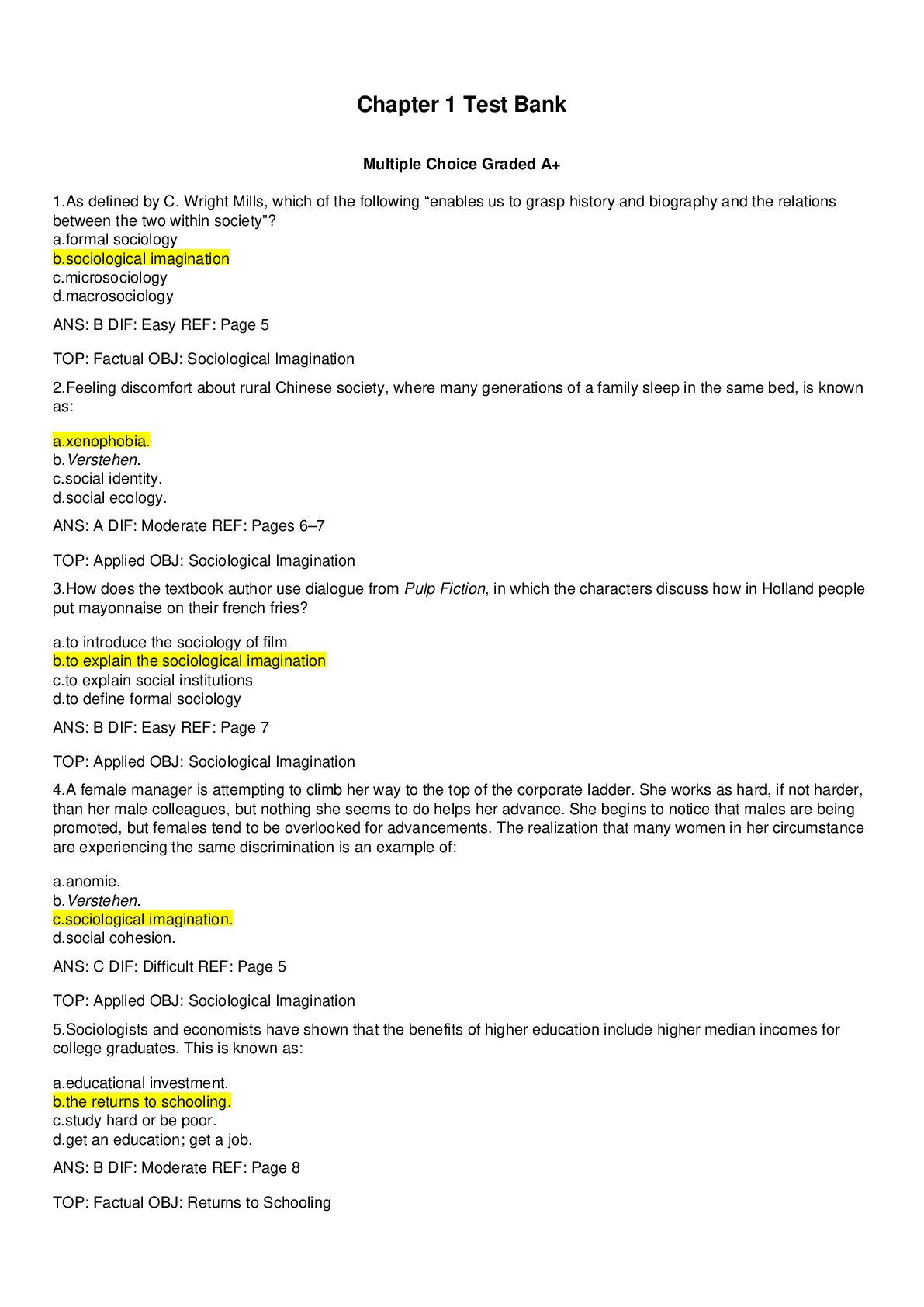
Buy this document to get the full access instantly
Instant Download Access after purchase
Add to cartInstant download
Reviews( 0 )
Document information
Connected school, study & course
About the document
Uploaded On
Sep 29, 2019
Number of pages
13
Written in
Additional information
This document has been written for:
Uploaded
Sep 29, 2019
Downloads
0
Views
87

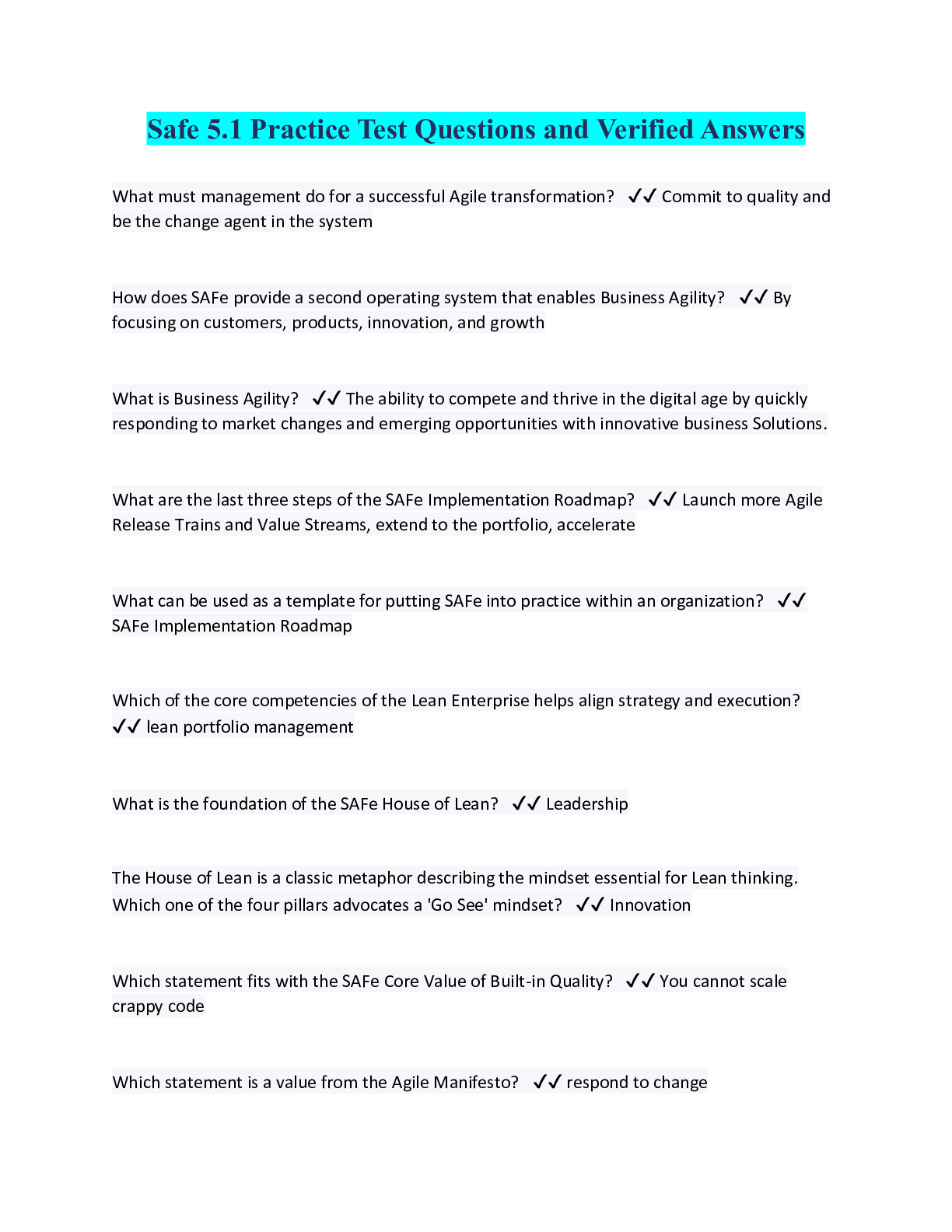
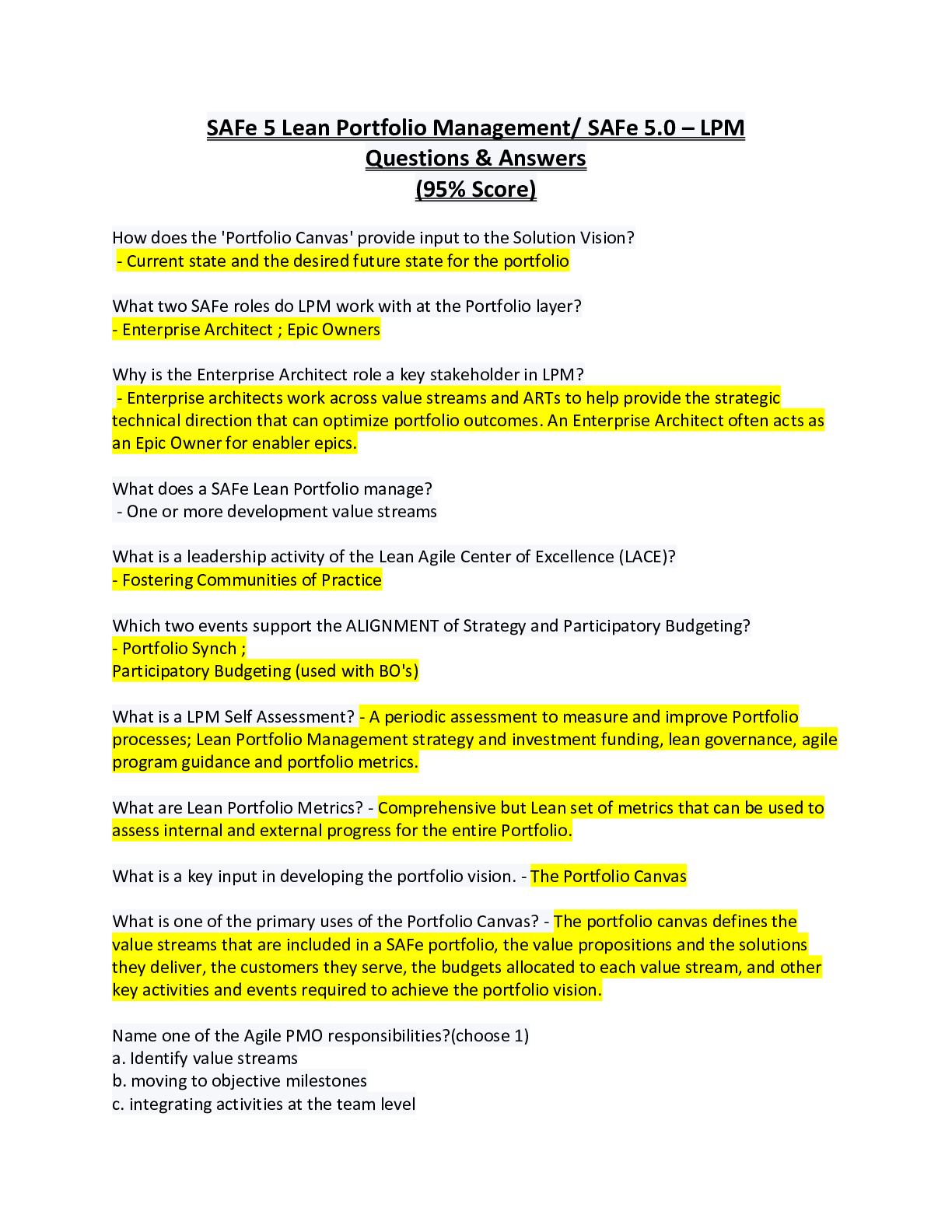

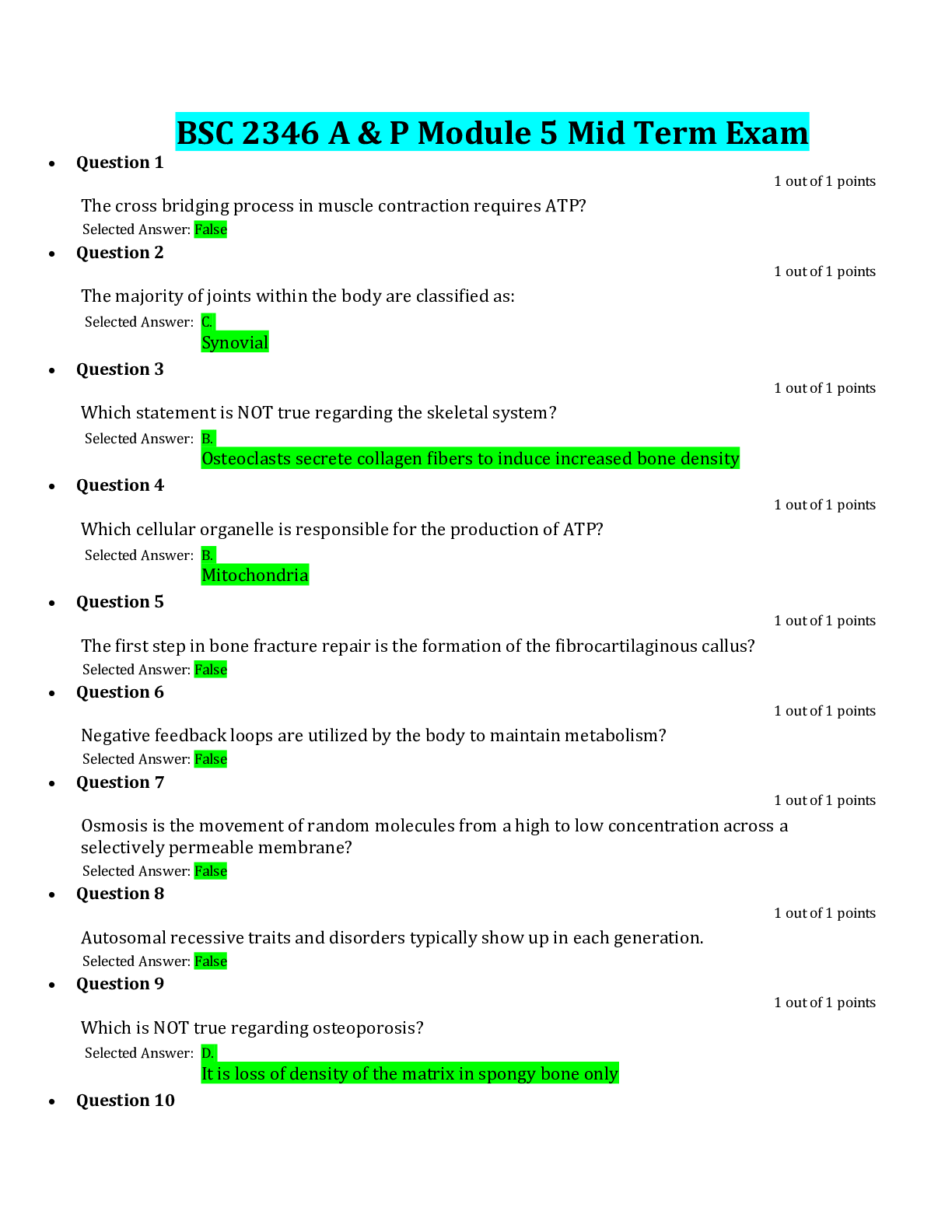
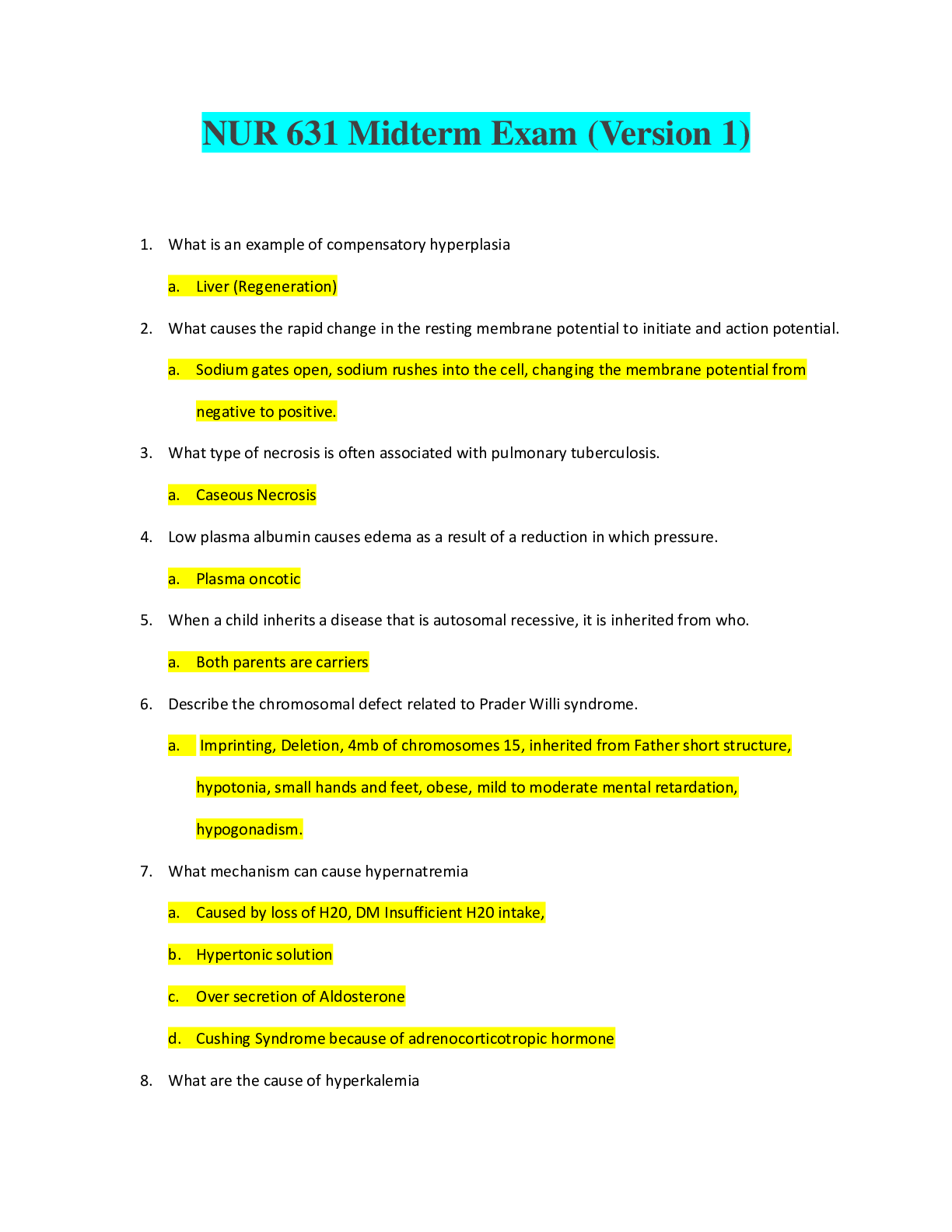


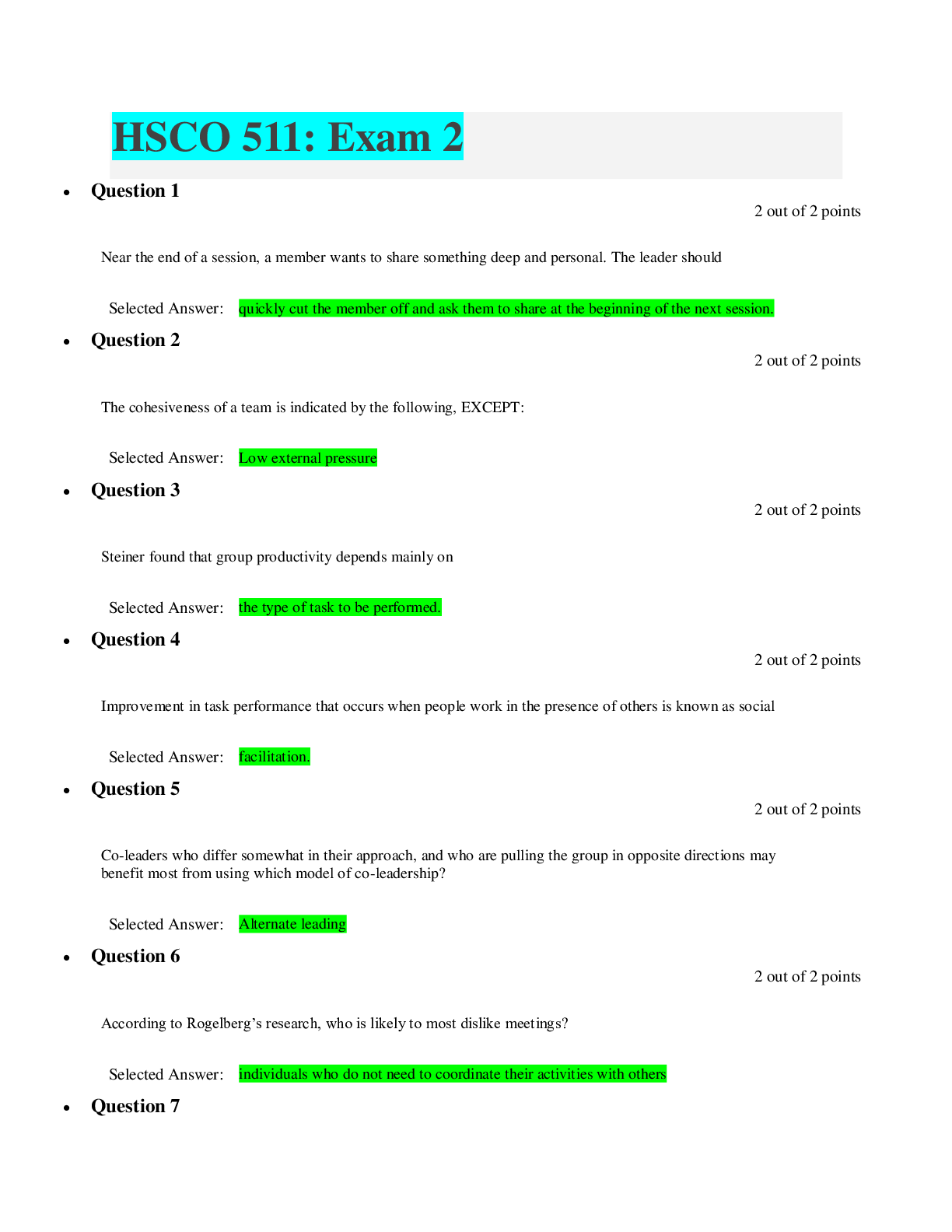
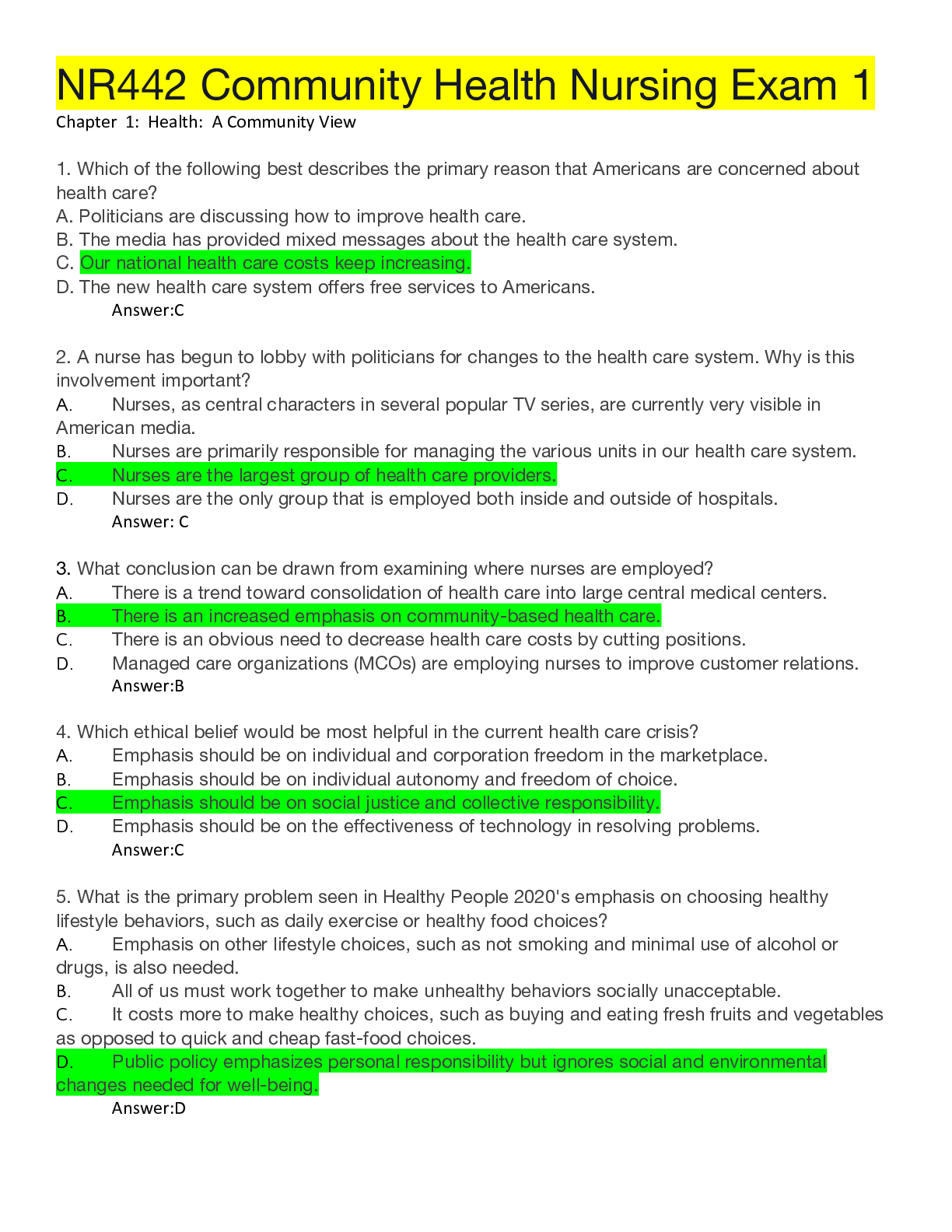
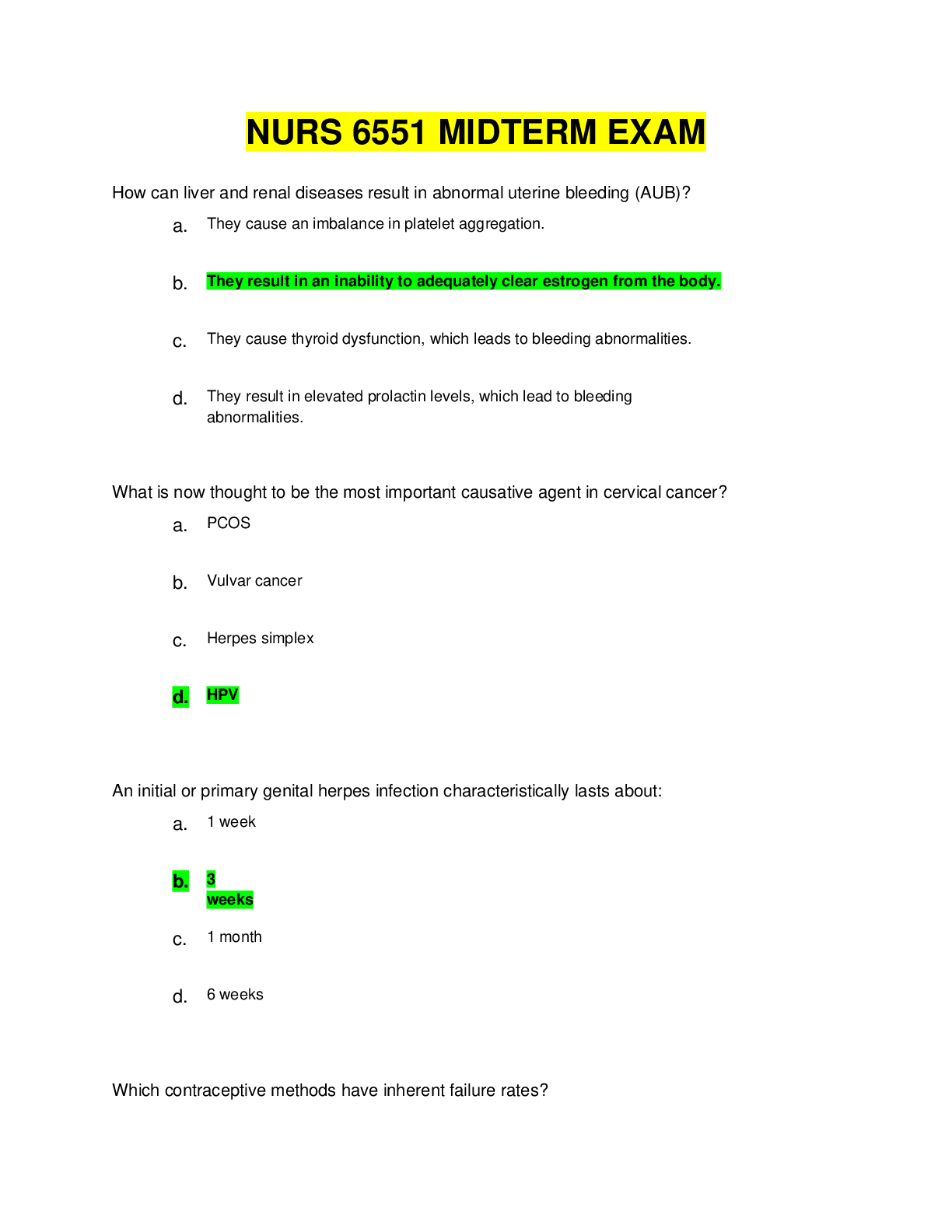
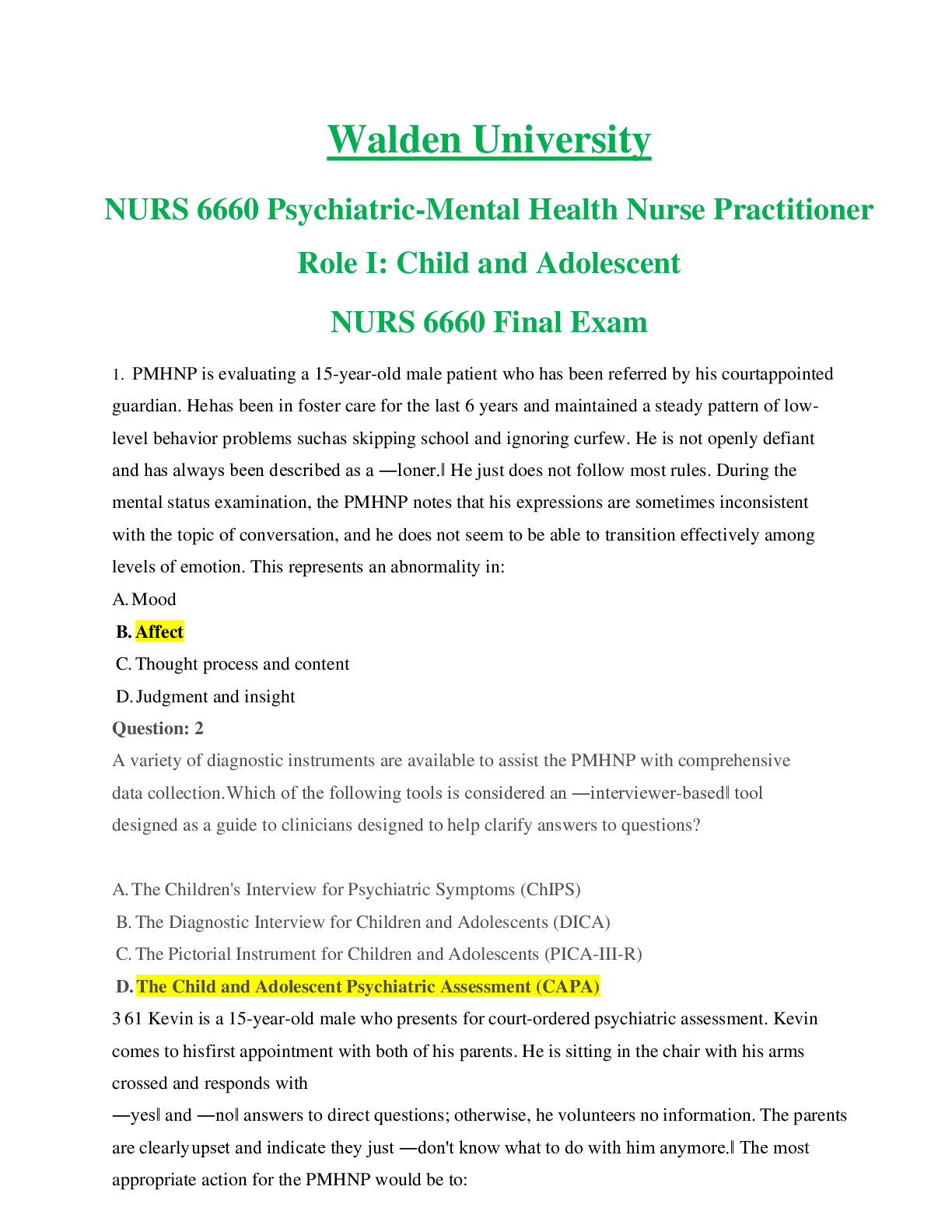

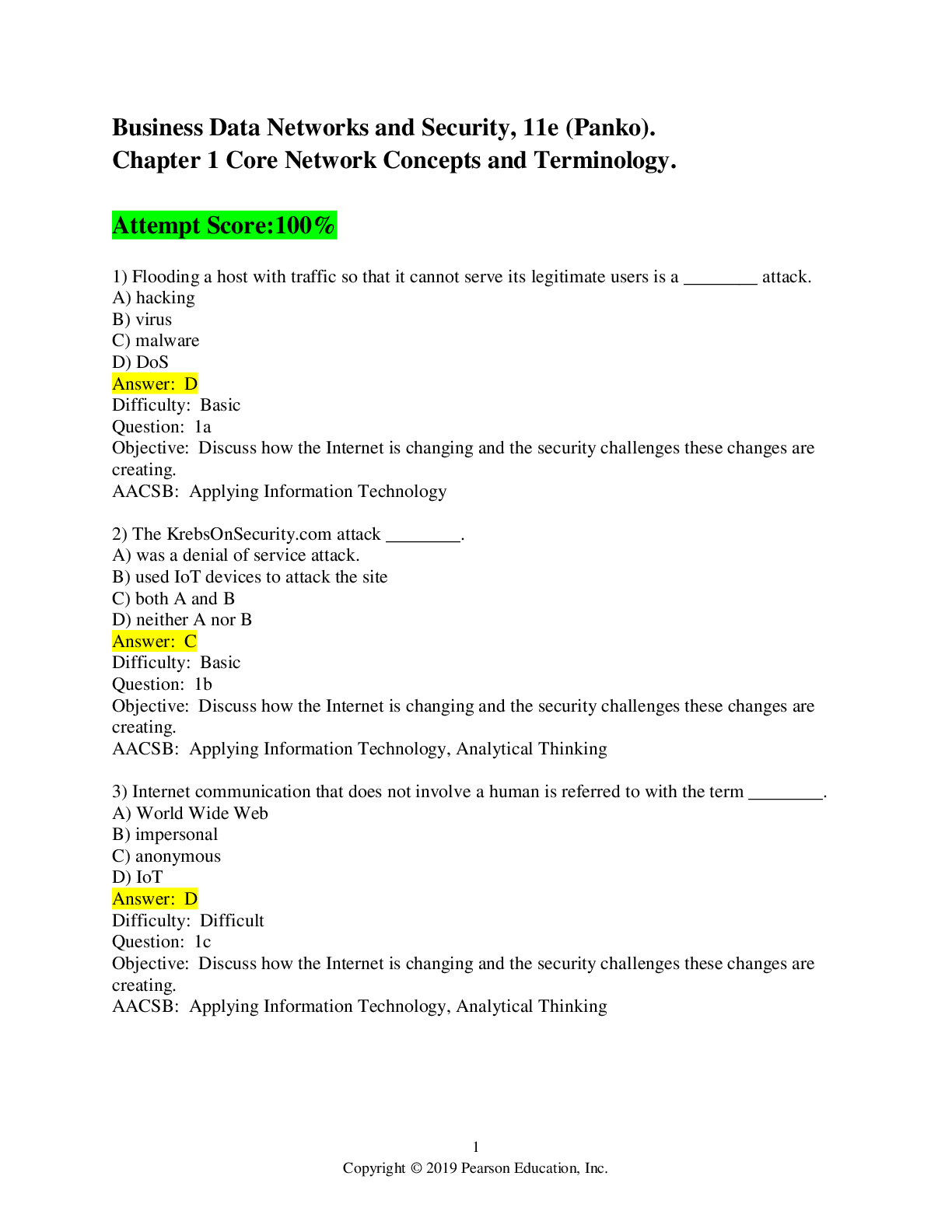

.png)
.png)

.png)

